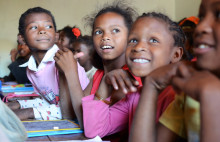It’s nearly impossible to read a news story or hear a network or cable broadcast without coming to the conclusion that we’re moving backwards, and that, to use the now-trite phrase, the world is “going to hell in a hand basket.”
That’s why Nicholas Kristof’s recent New York Times op-ed is so refreshing. It turns this gloom and doom on its head and instead of relying on “alternative facts,” looks at where we stand in the realm of human progress. Here is part of what he said:
There’s a broad consensus that the world is falling apart, with every headline reminding us that life is getting worse.
Except that it isn’t. In fact, by some important metrics, 2016 was the best year in the history of humanity. And 2017 will probably be better still. Here, take my quiz:
On any given day, the number of people worldwide living in extreme poverty:
A.) Rises by 5,000, because of climate change, food shortages and endemic corruption.
B.) Stays about the same.
C.) Drops by 250,000.
Polls show that about 9 out of 10 Americans believe that global poverty has worsened or stayed the same. But in fact, the correct answer is C. Every day, an average of about a quarter-million people worldwide graduate from extreme poverty, according to World Bank figures.
Or if you need more of a blast of good news, consider this: Just since 1990, more than 100 million children’s lives have been saved through vaccinations, breast-feeding promotion, diarrhea treatment and more. If just about the worst thing that can happen is for a parent to lose a child, that’s only half as likely today as in 1990.
When I began writing about global poverty in the early 1980s, more than 40 percent of all humans were living in extreme poverty. Now fewer than 10 percent are. By 2030 it looks as if just 3 or 4 percent will be. (Extreme poverty is defined as less than $1.90 per person per day, adjusted for inflation.)
Want more? You can read the full article here.


